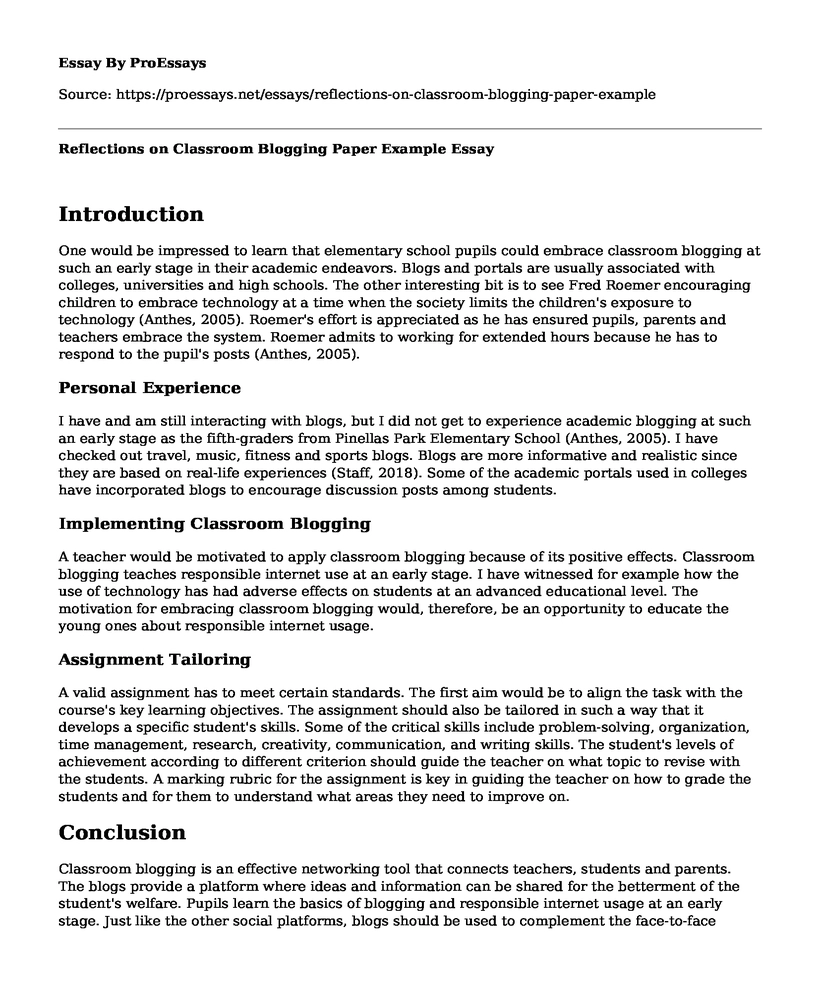Introduction
One would be impressed to learn that elementary school pupils could embrace classroom blogging at such an early stage in their academic endeavors. Blogs and portals are usually associated with colleges, universities and high schools. The other interesting bit is to see Fred Roemer encouraging children to embrace technology at a time when the society limits the children's exposure to technology (Anthes, 2005). Roemer's effort is appreciated as he has ensured pupils, parents and teachers embrace the system. Roemer admits to working for extended hours because he has to respond to the pupil's posts (Anthes, 2005).
Personal Experience
I have and am still interacting with blogs, but I did not get to experience academic blogging at such an early stage as the fifth-graders from Pinellas Park Elementary School (Anthes, 2005). I have checked out travel, music, fitness and sports blogs. Blogs are more informative and realistic since they are based on real-life experiences (Staff, 2018). Some of the academic portals used in colleges have incorporated blogs to encourage discussion posts among students.
Implementing Classroom Blogging
A teacher would be motivated to apply classroom blogging because of its positive effects. Classroom blogging teaches responsible internet use at an early stage. I have witnessed for example how the use of technology has had adverse effects on students at an advanced educational level. The motivation for embracing classroom blogging would, therefore, be an opportunity to educate the young ones about responsible internet usage.
Assignment Tailoring
A valid assignment has to meet certain standards. The first aim would be to align the task with the course's key learning objectives. The assignment should also be tailored in such a way that it develops a specific student's skills. Some of the critical skills include problem-solving, organization, time management, research, creativity, communication, and writing skills. The student's levels of achievement according to different criterion should guide the teacher on what topic to revise with the students. A marking rubric for the assignment is key in guiding the teacher on how to grade the students and for them to understand what areas they need to improve on.
Conclusion
Classroom blogging is an effective networking tool that connects teachers, students and parents. The blogs provide a platform where ideas and information can be shared for the betterment of the student's welfare. Pupils learn the basics of blogging and responsible internet usage at an early stage. Just like the other social platforms, blogs should be used to complement the face-to-face interactions. Parents, for example, should not rely so much on the blog posts and forget to spend quality time with their children. Classroom blogging should, therefore, be encouraged, however; it should not replace or limit face-to-face interactions.
References
Anthes, E. (2005). Blogging Classroom Connects to Parents. Retrieved from https://www.bridges4kids.org/articles/2005/8-05/Anthes8-9-09.html
Staff, E. (2018). Revealed: Which are the Most Popular Types of Blogs? Retrieved from https://www.wpbeginner.com/beginners-guide/which-are-the-most-popular-types-of-blogs/
Cite this page
Reflections on Classroom Blogging Paper Example. (2022, Nov 20). Retrieved from https://proessays.net/essays/reflections-on-classroom-blogging-paper-example
If you are the original author of this essay and no longer wish to have it published on the ProEssays website, please click below to request its removal:
- Symbolism in the Poetry of Renaissance Authors Sir Phillip Sidney and Edmund Spenser
- Is Facebook Making Us Lonely?
- Writing for Readers Paper Example
- Animism Inside Japanese Animations Paper Example
- Essay on Standardized Testing: Time to Rethink the Purpose
- Understanding Historical Themes: Linking Past and Present - Essay Sample
- Article Review Sample on Creating an Effective Online Learning Environment







